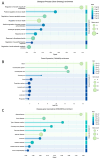Red-Wine Gene Networks Linked to Exceptional Longevity in Humans
- PMID: 41154643
- PMCID: PMC12562682
- DOI: 10.3390/biom15101414
Red-Wine Gene Networks Linked to Exceptional Longevity in Humans
Abstract
Despite the health concerns regarding alcohol and its link to cancer, moderate consumption of red wine has been associated with healthy aging and longevity, defined as up to one drink per day for women and two drinks per day for men (approximately 142 mL or 5 oz per drink). Previous research has revealed the health benefits of red wine, particularly in relation to cardiovascular disease. However, the influence of genetic factors on these benefits remains to be elucidated. In this study, we explored genes linked to red wine and created a curated gene set that intersects with those related to centenarians, which are markers of exceptional longevity. By analyzing literature from over 190 databases, we identified and validated a curated list of 43 genes associated with red wine and centenarians. We conducted gene set enrichment analysis as well as enrichment analysis of diseases and their tissue distributions. The results suggest that these genes play a crucial role in stress response and apoptosis, which are essential for cell survival and renewal. Additionally, these genes were enriched in pathways associated with smooth muscle cell proliferation, neuroinflammation, nucleotide excision repair, and lipoprotein metabolism (false discovery rate, FDR < 3 × 10-7). Gene set enrichment analysis indicated significant tissue distribution in the gastrointestinal, cardiovascular, and respiratory systems. Furthermore, the disease-gene enrichment analysis pointed to associations with diseases related to tissues and organs, including cardiovascular disease (heart disease and stroke), type 2 diabetes, gastrointestinal diseases and metabolic diseases, immune diseases, and cancer (FDR < 9.37 × 10-6); notably, cardiovascular diseases, diabetes, and cancer are leading causes of death, suggesting that these genes may be protective against those diseases. Our review of the literature indicates that individuals who do not currently drink alcohol should not be encouraged to start. However, we propose that moderate consumption of red wine, especially for middle-aged to older adults after 40 years old, can provide significant health benefits due to its components and the positive effects of hormesis. Although further research is necessary to uncover additional genes, this study provides the first genetic overview of the health benefits of red wine, emphasizing its potential in supporting healthy aging and longevity.
Keywords: aging; alcohol; alternative medicine; catechins; centenarian; gallic acid; hormesis; longevity; polymorphism; polyphenol; red wine; resveratrol; rotundone.
Conflict of interest statement
The authors declare no conflict of interest.
Figures





References
-
- Sziraki A., Lu Z., Lee J., Banyai G., Anderson S., Abdulraouf A., Metzner E., Liao A., Banfelder J., Epstein A., et al. A global view of aging and Alzheimer’s pathogenesis-associated cell population dynamics and molecular signatures in human and mouse brains. Nat. Genet. 2023;55:2104–2116. doi: 10.1038/s41588-023-01572-y. - DOI - PMC - PubMed
Publication types
MeSH terms
LinkOut - more resources
Full Text Sources

